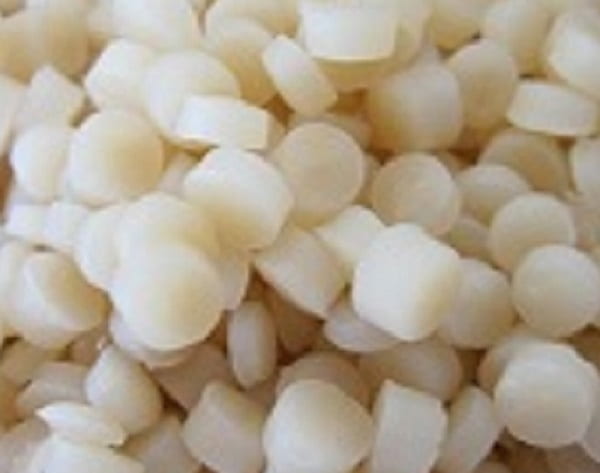rPET – Green Hydrogen – Plastic 07-06-2023 - Arhive
rPET – Green Hydrogen – Plastic
Crude Oil Prices Trend
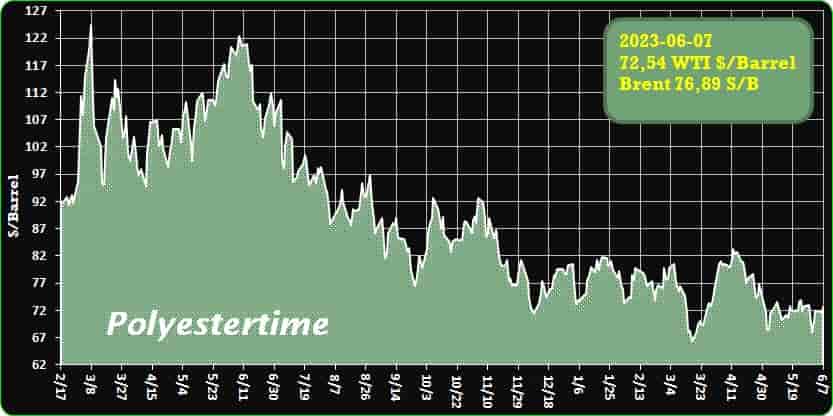
Crude Oil Prices Trend by Polyestertime
-Introducing Revolutionary Recycling Solutions for rPET & PU Waste by RAMPF
Visit Booth 1903 at Foam Expo 2023 in Novi, MI, from June 20 to 22 to witness the cutting-edge technology presented by RAMPF Group, Inc. This groundbreaking innovation enables the chemical recycling of rPET and polyurethane (PU) waste into premium-quality polyols.
Through ingenious chemical processes, RAMPF efficiently recycles the following waste materials into high-quality polyols:
- Post-consumer PET sourced from beverage bottles, fabrics, and fibers.
- PU foam scraps obtained from used mattresses, carpets, flooring, furniture, car seats, motorcycle seats, insulation materials, as well as fitness and leisure items.
Key features of RAMPF’s recycled polyols:
- Manufactured using solvolysis techniques, including glycolysis, acidolysis, and aminolysis.
- Delivering a level of quality and technical properties comparable to polyols derived from virgin raw materials.
- Tailored precisely to fit the customer’s production setup, enabling direct usage in the manufacturing of new products.
Additionally, RAMPF has developed advanced chemical processes that allow for the utilization of PET/PSA, other polyesters like PLA, PC, PHB, and renewable/bio-based raw materials such as vegetable oils as viable sources for manufacturing bio-based recycled polyols. rPET – Green Hydrogen – Plastic
The company also offers comprehensive consultation services for polyurethane recycling, as well as the development of customized polyols. As part of their extensive portfolio, RAMPF provides formulation expertise for polyurethane systems using their upcycled polyols, and offers contract manufacturing services for molded components.
By leveraging their chemical expertise alongside partnerships with industrial plant construction specialists, RAMPF has achieved remarkable success in global markets, offering a unique product range: turnkey multi-functional recycling plants for their customers.
Companies can now utilize their own tailored plants and polyurethane waste materials, such as PET, phthalic anhydride, and polyisocyanurate, to produce high-quality recycled polyols on-site. This not only reduces costs but also contributes to environmental preservation.
Join RAMPF in embracing sustainable practices and witness the future of recycling at Foam Expo 2023! rPET – Green Hydrogen – Plastic
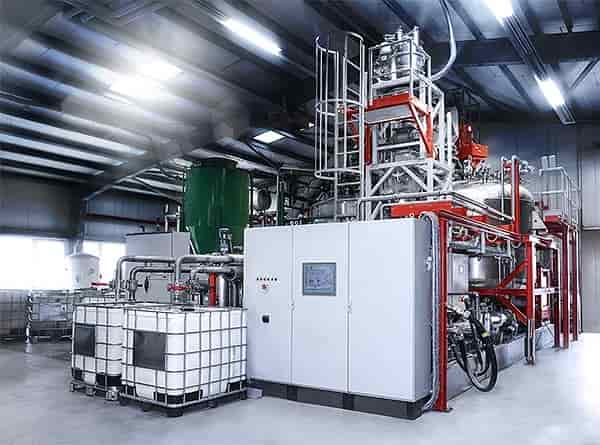
-New Efforts in Reducing Green Hydrogen Production Costs
As part of efforts to develop a decarbonized economy, green hydrogen, which produces hydrogen without the use of fossil fuels or the emission of carbon dioxide, has gained popularity recently.
However, the economic viability of green hydrogen has not been very high due to the high manufacturing cost of water electrolysis devices that generate green hydrogen. However, the discovery of a technique that substantially reduces the amount of rare metals utilized in polymer electrolyte membrane water electrolysis devices, like iridium and platinum, is paving the way for lower production costs.
Dr. Hyun S. Park and Sung Jong Yoo of the Korea Institute of Science and Technology’s (KIST) Hydrogen and Fuel Cell Research Center announced the development of a technology that can substantially decrease the quantity of platinum and iridium, precious metals employed in the electrode protection layer of polymer electrolyte membrane water electrolysis devices while maintaining performance and durability comparable to existing devices. rPET – Green Hydrogen – Plastic
In particular, the researchers replaced the expensive precious metal in the electrode protection layer with inexpensive iron nitride with a greater surface area and homogeneously coated a small amount of iridium catalyst on top of it, greatly enhancing the economic effectiveness of the device. This is in contrast to prior studies that focused on reducing the amount of iridium catalyst while maintaining the structure that uses a large amount of platinum and gold as the electrode protection layer.
The polymer electrolyte membrane water electrolysis device creates high-purity hydrogen and oxygen by decomposing water using electricity supplied by renewable energy sources such as solar power, and it is used to provide hydrogen to industries like steelmaking and chemicals. Furthermore, because it is beneficial for energy conversion to store renewable energy as hydrogen energy, enhancing the economic efficiency of this device is critical for achieving a green hydrogen economy.
There are two electrodes in a typical electrolysis device that generates hydrogen and oxygen, and for the oxygen-generating electrode, which works in an extremely corrosive environment, gold or platinum is coated on the surface of the electrode at 1 mg/cm2 as a protective layer to guarantee durability and production efficiency, and 1–2 mg/cm2 of iridium catalyst is coated on top. rPET – Green Hydrogen – Plastic
The precious metals utilized in these electrolysis devices have extremely limited deposits and production, which is a major impediment to the widespread adoption of green hydrogen generation devices.
To enhance the economics of water electrolysis, the researchers employed iron nitride (Fe2N) instead of the precious metals gold and platinum as a protective layer for the oxygen electrode in polymer electrolyte membrane hydrogen generation devices.
To do this, the researchers devised a composite process that coats the electrode uniformly with iron oxide, which has poor electrical conductivity and then transforms the iron oxide to iron nitride, which has higher conductivity.
The team also developed a procedure for uniformly coating an iridium catalyst around 25 nanometers (nm) thick on top of the iron nitride protective layer, resulting in an electrode with high hydrogen production efficiency and durability.
The designed electrode substitutes the gold or platinum used as a protective layer for the oxygen-generating electrode with non-precious metal nitrides while retaining comparable performance to existing commercial electrolysis units and reducing the amount of iridium catalyst to 10% of the current level.
Furthermore, the electrolysis unit with the new components was run for over 100 hours to ensure its initial stability. rPET – Green Hydrogen – Plastic
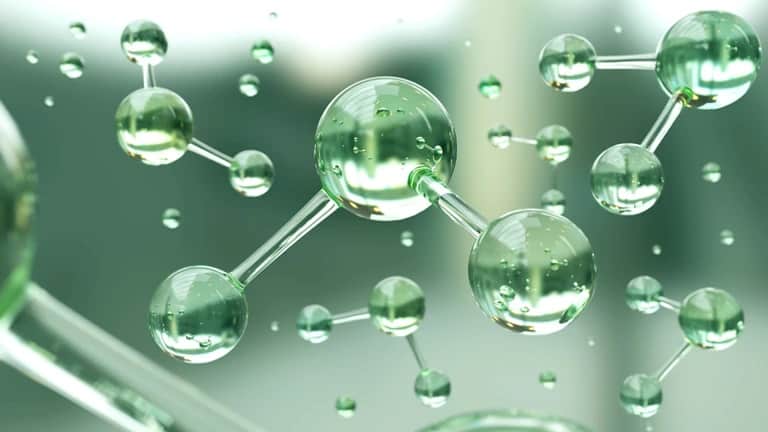
-Polymer Resources Ltd., a leading U.S. compounding company specializing in high-quality engineering resins, has announced the successful completion of its expansion and modernization project at its compounding facility in Rochester, New York
According to Manufacturing, the facility upgrades were undertaken to meet the growing demand for engineering resins from customers.
To address the increasing needs of its customers, Polymer Resources transformed an existing building on its campus, resulting in a 40% expansion of the compounding capacity. The revamped facility now includes enhanced capabilities for grinding and shredding, enabling the recycling of plastic waste to support circularity and sustainability initiatives.
In addition to the increased production capacity, the facility’s layout has been optimized, incorporating new safety features and amenities that promote a comfortable and efficient working environment for employees. As the company foresees a significant increase in its workforce in the coming years, these improvements will accommodate the projected double-digit growth. rPET – Green Hydrogen – Plastic
Polymer Resources President and COO, Scott Anderson, emphasized the facility’s contribution to advancing sustainability through plastic waste collection and recycling. He expressed the company’s commitment to assisting customers in achieving their production and sustainability targets while also striving to fulfill its own sustainability goals. Anderson believes that the new facility will play a pivotal role in realizing these objectives.
Completed in just over a year, the project resulted in the consolidation of the compounding facility’s footprint from two separate buildings spanning 35,000 square feet to a single building encompassing 60,000 square feet. This expansion allows for more spacious compounding and grinding operations, enhanced storage capacity, a dedicated laboratory, and office space. Moreover, the Rochester site provides Polymer Resources with the opportunity to potentially expand the building to a total of 100,000 square feet in the future. rPET – Green Hydrogen – Plastic
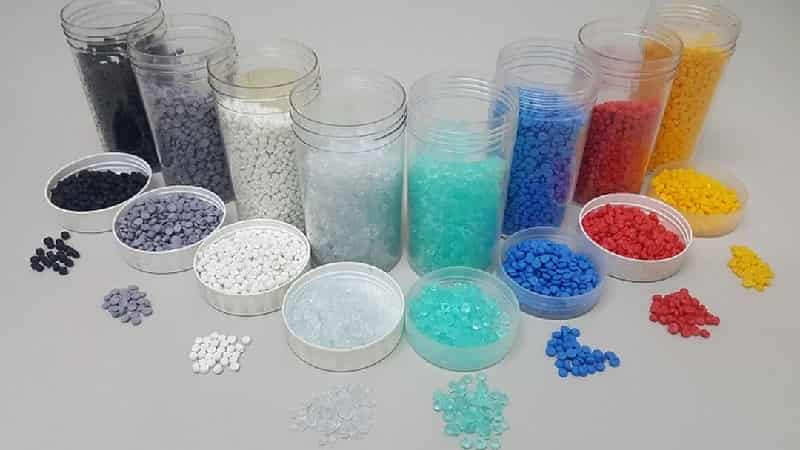
-Coveris Unveils New Recycling Facility, ReCover, at Louth Site Coveris, a leading packaging manufacturer, has recently inaugurated its state-of-the-art ReCover plant at its Louth facility in Lincolnshire, UK
This cutting-edge facility incorporates groundbreaking technology to recycle printed polyethylene (PE) films.
Located within the PE extrusion and conversion site of Coveris Louth, the dedicated ReCover facility employs an innovative de-inking recycling process. This process effectively eliminates ink from printed film packaging waste, enabling the regranulation of the material into high-quality recycled PE resin called ReGen. Over a span of two years, the development of ReCover Louth has established a robust recycling infrastructure within the packaging industry, ensuring a consistent supply of superior-grade recycled resin, ReGen, for use in packaging film production.
The facility comprises a fully equipped ReCover Lab, serving as a hub for innovation, quality control, and validation of ReGen recyclate and its application in Coveris’ extrusion of recycled content films. rPET – Green Hydrogen – Plastic
ReCover Louth has an annual production capacity of 5,000 tonnes of ReGen pellets. The facility utilizes printed waste feedstock from within the Coveris Group, as well as production waste from its customers and suitable post-industrial waste films from the industry. Initially, ReGen pellets will be primarily utilized to meet the recycled content requirements within the Coveris Group. Additionally, they comply with the UK Plastic Packaging Tax and actively support the goals of the UK Plastic Pact.
Source: Coveris
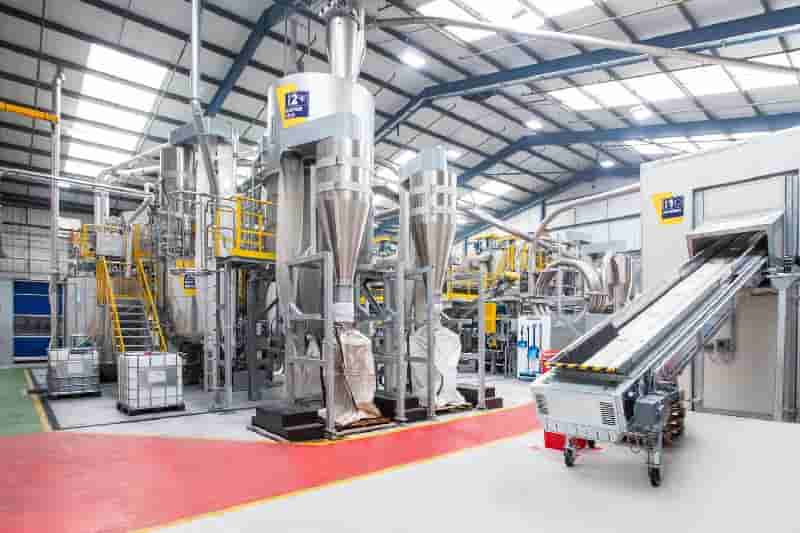
-Recyclers in Europe are urging the implementation of a Critical Raw Materials Regulation that promotes circularity in the region
They have raised concerns about the proposed amendments found in the ITRE’s draft report on the EU COM proposal on Critical Raw Materials, which was published on May 26 and 30, 2023.
While some proposals emphasize the need for transparency when the Commission adds or removes a raw material from the list in Annex I & II, Section 1, the recyclers have noted that certain materials are being suggested for addition without proper justification. They strongly believe that any proposal included in EU legislation should be backed by scientific evidence-based assessments.
EuRIC, the European Recycling Industries Confederation, also insists that the Commission should review and potentially update the list of critical raw materials four years after its implementation and every four years thereafter. Reducing the frequency of updates would create uncertainty regarding capital investments.
In terms of proposals suggesting export restrictions, EuRIC strongly opposes them, as they contradict the concept of “free trade.” The recyclers argue that recycled materials meeting industry specifications or international standards should have access to international markets. They highlight that decisions regarding exports are already governed by the EU Waste Shipment Regulation and should not be the focus of this particular legislative act. rPET – Green Hydrogen – Plastic
Furthermore, EuRIC welcomes proposals that aim to advance the adoption date of the Delegated Acts, which will determine the targets for recycled content mentioned in Article 28 of the proposal. However, they believe that the scope of the Article should be expanded, as they see a lack of ambition in its current form.
Emmanuel Katrakis, Secretary General of EuRIC, warned that the decisions made on various legislative proposals, including the Critical Raw Materials proposal, will shape the future of the EU recycling industry. These decisions are crucial for achieving the ambitious targets outlined in both the EU Green Deal and the Circular Economy Action Plan (CEAP).
Source: Euric

-Freudenberg opens new competence centre
Freudenberg Performance Materials Apparel Europe has expanded its facility in Sant´Omero, Italy, into a competence centre for finishing and coating apparel interlinings.
According to Freudenberg, customers will benefit from faster and more flexible order processing while in the long term, they will also be able to count on products originating in Europe. The Competence Center was officially opened on May 26, 2023.
The Freudenberg team in Sant´Omero has over 35 years of expertise in the manufacture of high-quality interlinings for menswear: base materials produced at the site are finished and coated to customers’ specifications. With the new competence centre, the facility will now focus on coating and finishing all nonwoven, woven and weft apparel interlinings in Freudenberg’s portfolio. rPET – Green Hydrogen – Plastic
“Freudenberg stands for a high level of technical know-how and comprehensive experience in apparel interlinings – from product development through to consultation. With the new competence center in the core Italian market, our customers will benefit from even greater production flexibility and swifter delivery,” Dr. Hannah Koeppen, General Manager Freudenberg Performance Materials Apparel Europe, explained.
Freudenberg installed the necessary finishing and coating technology at the new competence center in Italy over the last few months, building a new production hall for this machinery and equipment. Until recently, the bulk of interlinings were coated and finished in Weinheim, Germany. The facility there will now operate as a further competence center specializing in the production of base materials for apparel interlinings.
In addition to establishing the competence center, Freudenberg has also improved logistics. A new central warehouse in Italy now supplies customers in Southern Europe. It complements the central warehouse in Germany that delivers goods to customers in Northern Europe, effectively shortening both delivery routes and delivery times.
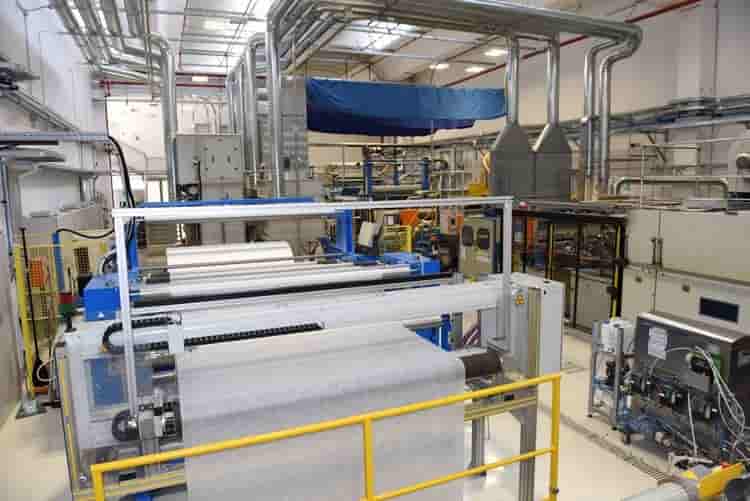
-The newest Sustainable Plastics is live!
It’s an issue that takes a look at, amongst other things, defossilisation, in a contribution from the founders of the Renewable Carbon Initiative; how to grow PHA; chemical recycling – and the role of sustainable plastics in the mobility transition. And it was this latter topic that led me to reflect on the following.
A few weeks ago, I was invited – by Dow – to attend a car race. Now, as a relatively non-competitive type of person with a negligible interest in sports, the notion of spending an afternoon watching outsized toy cars drive around a track without actually ever going anywhere sounded less than thrilling. rPET – Green Hydrogen – Plastic
On the other hand, I’d never been to an actual car race before – and might never get the opportunity to do so again. Plus, because it was a race in the Formula E series, the cars in question were electric ones, which seemed intriguing.
In the end, I said I’d be happy to accept the invitation, and with some trepidation and very little idea of what to expect, I went to Berlin.
And it was superb. Call me a convert: the race was sensational, complete with collisions and safety car laps; a suspenseful, spine-tingling competition that kept everyone on the edge of their seats.
There was nothing prim or subdued about the cars: these were full-blooded racing machines with a top speed of over 322km/h.
Sitting there, it also dawned on me that what I was watching was the future of electric mobility. This sport has achieved Net Zero Carbon certification since inception. The current generation of Formula E cars – Gen3 – is completely aligned to life cycle thinking. Natural rubber and recycled fibres make up 26% of the tires, which are fully recycled after racing. All waste carbon fibre is reused for new applications. The battery cells are reused and recycled at the end of life. The CO2 footprint of the car was measured from the start of the design phase onwards in order to determine all the measures that could help reduce its environmental impact. rPET – Green Hydrogen – Plastic
Formula E has been called ‘a laboratory for the future of electric mobility’. Race strategy is based on energy efficiency – allocating energy consumption across the race – which has led to the development of optimised energy management software, while lightweight materials – composites and plastics – play a key role by enhancing the performance-to-weight ratio.
The trickledown effect from race to road cannot be overestimated. The solutions and technologies, including sensors and other electronics, developed for the track will inevitably impact the efficiency, range, capabilities and safety of consumer electric vehicles as well.
And the plastics industry is contributing to this rapidly accelerating mobility transition by developing the new materials that these vehicles need. In this issue, we talk to three raw material producers, each of which, in its own way, is pushing the boundaries of performance for sustainably advantaged materials.
Electric vehicles are making more sustainable mobility possible, and, happily for the industry, plastics are a crucial part of that. rPET – Green Hydrogen – Plastic
